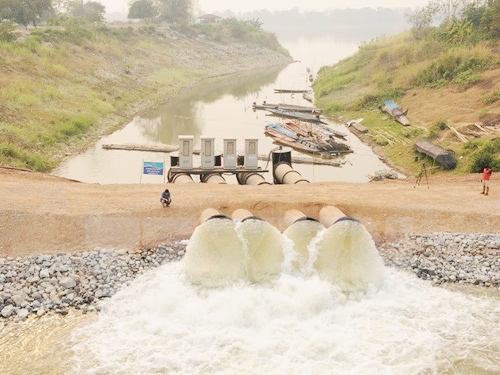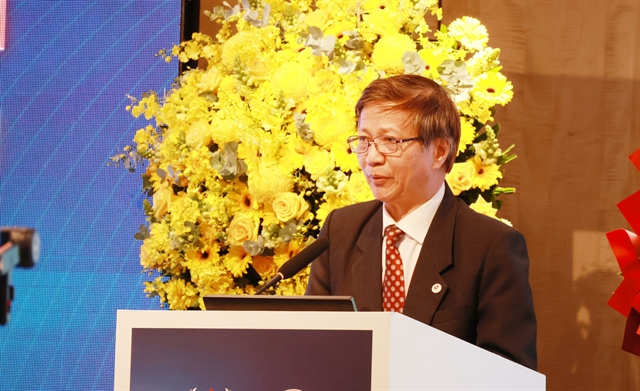 Society
Society

The south of Việt Nam is highly vulnerable to more drought and salinisation in the future when its fellow countries in the lower Mekong river basin are in the process of irrigating the river water to serve their expanding farm land, experts warned.
 |
| An irrigation project in Thailand. The south of Việt Nam is highly vulnerable to more drought and salinisation in the future when its fellow countries in the lower Mekong river basin are in the process of diverting the river water to serve their expanding farm land. — Photo moitruongvadoisong.vn |
HÀ NỘI — The south of Việt Nam is highly vulnerable to more drought and salinisation in the future when its fellow countries in the lower Mekong river basin are in the process of diverting the river water to serve their expanding farm land, experts warned.
The lower basin of the trans-boundary Mekong River starts from Laos and runs through Thailand, Cambodia and Việt Nam before emptying into the East Sea (South China Sea). Any attempts to interrupt the natural status of the river would pose risks to Việt Nam’s Cửu Long (Mekong) delta where more than 17 million people rely on the river for a living.
Apart from the biggest threat coming from a string of major hydroelectric projects and dams along the Mekong river, such interruptions now even include new irrigation systems in the other three lower Mekong nations. They would drain more water from the river to support their growing agricultural sector and leave less water for Việt Nam, said Nguyễn Nhân Quảng, an independent researcher on river basin management at a workshop held by local non-profit organisation PanNature on Tuesday.
In its economic development master plans with vision to 2027, Thailand - one of the four lower Mekong nations – was aiming to transform its northeast region where the Mekong river runs to a food growing and bio-fuel producing centre of the nation, Quảng said.
“Therefore, new constructions and renovations to the irrigation system draining water from the Mekong River (in Thailand) are just a matter of time,” he said.
“Thailand is planning some 990 irrigation projects most of which are to pump water out of the Mekong”.
Cambodia and Laos are also on their way to expand their farming land to grow rice and industrial crops. Quảng said that Cambodia would add some 6,000 ha to the current 504,245 ha while Laos is planning a massive 238,617 ha of new agricultural land plus the existing 166,476 ha.
“Cửu Long delta is under tremendous strain when the water level will go down and down gradually,” Quảng said.
Nguyễn Hồng Toàn, a member of the Việt Nam’s Mekong River Commission, said at the workshop that Mekong water redirection was not new but had been initiated since 1960.
“Yet it was not until 2014 that Thailand and Cambodia redirected the river water on a larger scale,” he said.
Thailand by now is working on a project to irrigate Mekong river water through Nong Han District in Udon Thani Province to Lam Pao dam. The dam reservoir would be expanded to about 45 sq kilometres to hold water in addition to another new 30 reservoirs to be built. The water volume in and out annually would reach about 2.8 billion cubic metres, according to Quảng.
Cambodia, meanwhile, is building the US$200 million Vaico irrigation channels that link the Mekong River to the Krapik lake whose water volume is about 100 million cubic metres.
“The construction of hydroelectric dams has caused so many difficulties for the Cửu Long delta already. But now, hydroelectric combining with water redirection is very dangerous for our country, especially when we are at a disadvantaged geographical location like this,” Toàn said.
“About 95 per cent of the water flow into the Cửu Long delta comes from outside the country. If the water level is down, the delta will have to face even more serious drought and salinisation than ever before.”
The Cửu Long delta this year was hit by the worst drought in the last nine decades along with saltwater intrusion on a mass-scale. Việt Nam’s biggest rice basket suffered losses worth more than VNĐ4.7 trillion ($215 million) due to the disasters, with some 225,000 households short of fresh water.
Hydroelectric dams and irrigation systems would further cost 60 per cent of the silt essential for agriculture in the Cửu Long delta where more than half of the country’s staple food crops is grown, said Trần Xuân Thái from the Việt Nam Academy for Water Resources.
An expert of the Institute for Water and Environment Đặng Thị Hà Giang believed that interest conflicts between countries to use the water resources in the Mekong river basin were “unavoidable”, yet they should all calculate carefully to avoid “immeasurable consequences”.
“Experiences learnt from other rivers… show that with benefits gained in the upper, the costs are paid by the lower,” she said. — VNS




